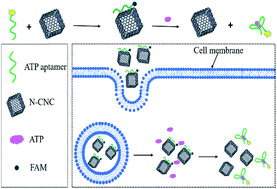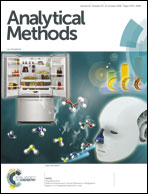Nitrogen doped carbon nanocage modulated turn-on fluorescent probes for ATP detection in vitro and imaging in living cells†
Abstract
In this work, nitrogen-doped carbon nanocage (N-CNC) modulated turn-on fluorescent probes were developed for selective detection of adenosine monophosphate (ATP), and their application for imaging of ATP in living cells was demonstrated. The as-synthesized N-CNC nanoprobes exhibited minimal background fluorescence due to the interaction between ssDNA and the N-CNCs. The aptamer was adsorbed onto the surface of N-CNCs forming an aptamer/N-CNC nanocomplex, and the fluorescence was quenched by the N-CNCs through Förster resonance energy transfer. In the in vitro assay, the introduction of ATP led to the dissociation of the aptamer from the N-CNCs’ surface. The limit of detection was as low as 5 μM in the range of 5 μM to 2 mM, and the nanocomplex was highly selective toward ATP. The in vivo studies suggested that the N-CNC nanoprobes showed excellent biocompatibility and successfully worked for specific, high-contrast imaging of ATP in living cells. Noncovalent binding between N-CNCs and oligonucleotides along with excellent solubility and biocompatibility have shown N-CNCs to be an efficient carrier and provide excellent protection for cellular delivery of genes. They may be an excellent candidate for many biological applications, such as gene and drug delivery, intracellular imaging, and in vivo molecular analysis.



 Please wait while we load your content...
Please wait while we load your content...